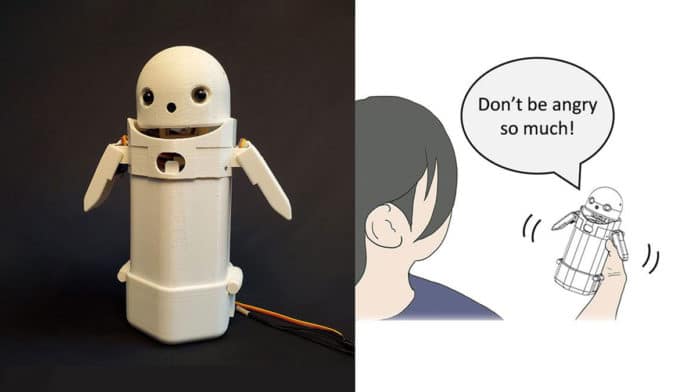Text messaging devices brought huge benefits to interpersonal communication in the last three decades. The advent of these devices has made people’s remote communication instant. However, it is often missing the human element that would accompany an explanation face-to-face or even over the phone.
Now, researchers at the University of Tsukuba, in Japan, have created a handheld social robot, called OMOY, that can appear to convey emotions while reading out text messages. It doesn’t do this by changing its facial expression or gesture, but only by movements caused by shifting an internal weight.
The text message mediator robot can help users control their anger when receiving upsetting news. Also, the device might help enhance social interactions as we move towards a world with increasingly digital communications.
The OMOY social robot is equipped with a movable weight actuated by mechanical components inside its body. It could express simulated emotions by shifting the internal weight during the time when the robot speaks out messages received from the human sender. The OMOY mediator robot is designed so that it can suppress the user’s anger and other negative interpersonal motivations, such as thoughts of revenge, and instead forester forgiveness.
The robot was deployed as a mediator for reading text messages. A text with unwelcome or frustrating news could be followed by an exhortation by OMOY to not get upset or even sympathize with the user. “With the medium of written digital communication, the lack of social feedback redirect focus from the sender and onto the content of the message itself,” author Professor Fumihide Tanaka says.
In a controlled study, researchers tested 94 people with a frustrating message “I’m sorry, I am late. The appointment slipped my mind. Can you wait another hour?” The team found that by introducing weight shifts together with the OMOY speech suppressed on average 23% of the user’s anger. However, only 3.5% of the anger was suppressed when the weight shifts were not applied. Additionally, in cases where the robot showed empathy to the user in words with weight shifts, the user’s revenge urge was successfully reduced by 22%.
“The mediator robot can relay a frustrating message followed by giving its own opinion. When this speech is accompanied by the appropriate weight shifts, we saw that that the user would perceive the ‘intention’ of the robot to help them calm down,” Professor Tanaka says.
The text reading robot’s body expression produced by weight shifts did not require any specific external components, such as arms or legs, which implied that the internal weight movements could reduce a user’s anger or other negative emotions without the use of rich body gestures or facial expressions.
